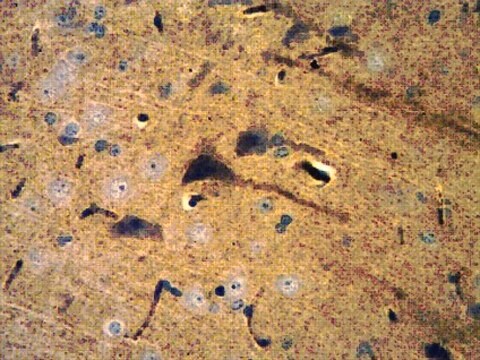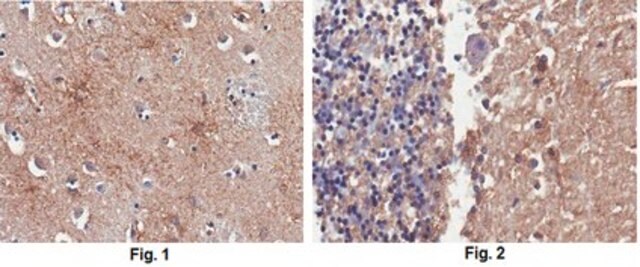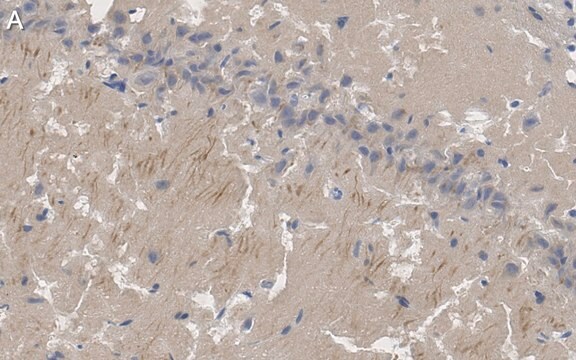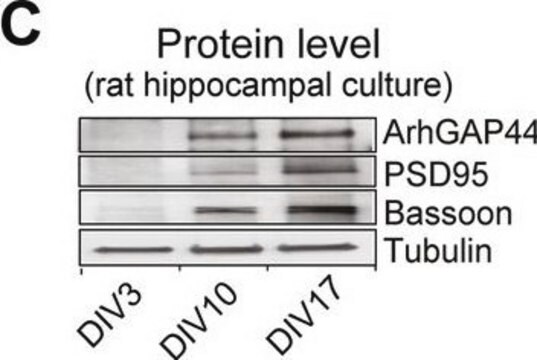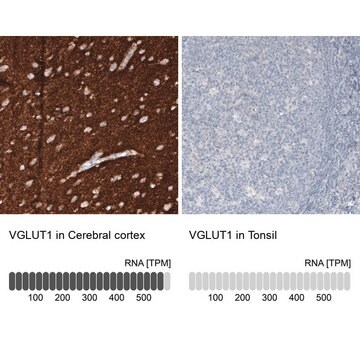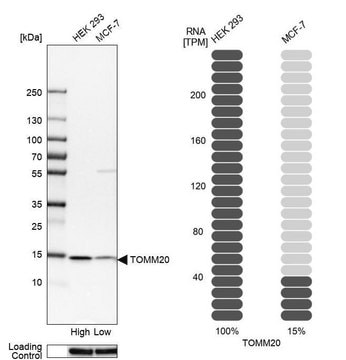P246
Monoclonal Anti-PSD95 antibody produced in mouse
clone 7E3-1B8, purified immunoglobulin, buffered aqueous solution
Synonym(s):
Anti-MRD62, Anti-PSD95, Anti-SAP-90, Anti-SAP90
Sign Into View Organizational & Contract Pricing
All Photos(1)
About This Item
Recommended Products
biological source
mouse
Quality Level
conjugate
unconjugated
antibody form
purified immunoglobulin
antibody product type
primary antibodies
clone
7E3-1B8, monoclonal
form
buffered aqueous solution
mol wt
antigen 95 kDa
species reactivity
rat
technique(s)
immunofluorescence: 1:500
immunoprecipitation (IP): suitable
western blot: 1:2,000
isotype
IgG2a
UniProt accession no.
shipped in
dry ice
storage temp.
−20°C
target post-translational modification
unmodified
Gene Information
rat ... Dlg4(29495)
General description
DLG4 (discs large MAGUK scaffold protein 4) gene codes for the postsynaptic density-95 (PSD95) protein. Postsynaptic density 95 (PSD-95), a synaptic scaffolding protein is also a membrane-associated guanylate kinase (MAGUK) family protein. It has three PDZ domains on the N terminus followed by a Src homology 3 (SH3) domain and a guanylate kinase (GK) domain. This gene is located on human chromosome 17p13.1.
Specificity
Reacts with both the recombinant and native rat PSD95. By immunofluorescence with rat hippocampal cells, a staining pattern coincident with NMDA receptor staining at synaptic sites consistent with its proposed role in receptor clustering is observed. Fixation with cold methanol is recommended.
Immunogen
recombinant rat PSD95 (post synaptic density 95 kDa).
Application
Applications in which this antibody has been used successfully, and the associated peer-reviewed papers, are given below.
Immunocytochemistry (1 paper)
Immunofluorescence (1 paper)
Western Blotting (1 paper)
Immunocytochemistry (1 paper)
Immunofluorescence (1 paper)
Western Blotting (1 paper)
Biochem/physiol Actions
Postsynaptic density 95 (PSD-95) plays a major role in bidirectional synaptic plasticity, an important process, essential for learning and memory. It exhibits increased dynamics upon induction of plasticity.
Physical form
Solution in phosphate buffered saline containing 0.05% sodium azide.
Disclaimer
Unless otherwise stated in our catalog or other company documentation accompanying the product(s), our products are intended for research use only and are not to be used for any other purpose, which includes but is not limited to, unauthorized commercial uses, in vitro diagnostic uses, ex vivo or in vivo therapeutic uses or any type of consumption or application to humans or animals.
Not finding the right product?
Try our Product Selector Tool.
Storage Class Code
10 - Combustible liquids
WGK
WGK 3
Flash Point(F)
Not applicable
Flash Point(C)
Not applicable
Personal Protective Equipment
dust mask type N95 (US), Eyeshields, Gloves
Choose from one of the most recent versions:
Already Own This Product?
Find documentation for the products that you have recently purchased in the Document Library.
Customers Also Viewed
Capping of the N-terminus of PSD-95 by calmodulin triggers its postsynaptic release
Yonghong Zhang
The Embo Journal (2014)
Human postsynaptic density-95 (PSD95): location of the gene (DLG4) and possible function in nonneural as well as in neural tissues
Stathakis D G, et al.
Genomics, 44(1), 71-82 (1997)
Decreased PSD95 expression in medial prefrontal cortex (mPFC) was associated with cognitive impairment induced by sevoflurane anesthesia* #
Yun-Zhi Ling
Journal of Zhejiang University. Science. B (2015)
Xiao-Mei Liu et al.
The Journal of biological chemistry, 281(25), 17432-17445 (2006-04-21)
Previous studies have suggested that glutamate receptor 6 (GluR6) subunit- and JNK-deficient mice can resist kainate-induced epileptic seizure and neuronal toxicity (Yang, D. D., Kuan, C.-Y., Whitmarsh, A. J., Rinoćn, M., Zheng, T. S., Davis, R. J., Rakic, P., and
Malwina Lisek et al.
Frontiers in cellular neuroscience, 11, 181-181 (2017-07-14)
Ketamine causes psychotic episodes and is often used as pharmacological model of psychotic-like behavior in animals. There is increasing evidence that molecular mechanism of its action is more complicated than just N-methyl-D-aspartic acid (NMDA) receptor antagonism and involves interaction with
Our team of scientists has experience in all areas of research including Life Science, Material Science, Chemical Synthesis, Chromatography, Analytical and many others.
Contact Technical Service